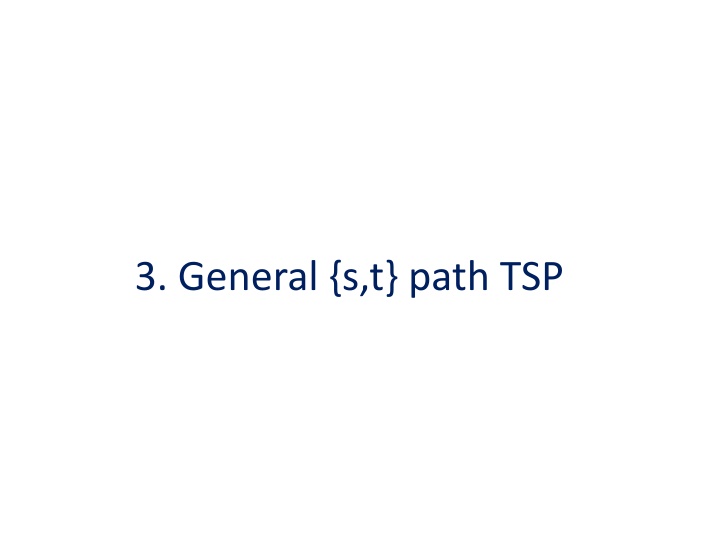
Facts and Insights on s-t Path TSP Polytope
Explore the intricacies of the s-t Path TSP Polytope, including discussions on optimization, integer points, and the challenges associated with achieving a ratio of 5/3 in certain scenarios.
Download Presentation

Please find below an Image/Link to download the presentation.
The content on the website is provided AS IS for your information and personal use only. It may not be sold, licensed, or shared on other websites without obtaining consent from the author. If you encounter any issues during the download, it is possible that the publisher has removed the file from their server.
You are allowed to download the files provided on this website for personal or commercial use, subject to the condition that they are used lawfully. All files are the property of their respective owners.
The content on the website is provided AS IS for your information and personal use only. It may not be sold, licensed, or shared on other websites without obtaining consent from the author.
E N D
Presentation Transcript
The {s,t}-path TSP PATH TSP INPUT : V cities, s , t V, c: V V IR+ metric OUTPUT: shortest s, t Hamiltonian path The LP, i.e. the s-t-path TSP polytope: P(V,s,t) = { x IR+E: x( (W)) 2, W V, s, t W or s s 1, if s,t separated by W = on vertices (1 for s, t , else 2 ) } t t = { x IR+E: x(E(W)) n-1, W V, = n-1, and = 1 on stars of s, t and else 2 as before }
Remarks about the s-t path TSP polytope Spanning tree polytope intersected with star inequalities ! Notation: OPT := min Ham s-t path length. OPTLP (s,t) := min { cTx : x P(V,s,t) } Integer points : Hamiltonian paths The proof of 2 is as easy, and `the two proofs of 5/3 are not difficult. Of Christofides algorithm Let us do 2 ! It looks easier, so why only 5/3 ?
Why 5/3 ? What is the difficulty ? None of the proofs for 3/2 work, Parity correction costs more than 1/2 : Deleting an {s,t}-join, what remains is not an {s,t}-join For x P(V,s,t), x(C)/2 < 1 is possible, x/2 is not in all T-join polyhedra. Def : A cut C is called narrow if x (C) < 2 Narrow cuts are the guilty ones !
Narrow cuts form a chain Lemma (An, Kleinberg, Shmoys, 2011) G=(V,E) graph, x P(V,s,t). The set of narrow cuts is a chain (Si) (i=1, , k ), s S1 Sk . T s S t Proof : Suppose not : 2+2 > d(S) + d(T) d(S T)+d(S T) 2 + 2 , a contradiction
The first results cycle or path cycle (s=t) (s,t)-path cardinality or weights Gamarnik,Lewenstein,Sviridenko (2005): 3/2 - for cubic 3-connected Boyd, Sitters,van der Ster,Stougie (2011): 4/3 for cubic Oveis, Gharan, Saberi, Singh (2011) : 3/2 - M mke, Svensson (2011) : 1.461 Mucha (2011) : 13/9=1.444 cardinality Hoogeveen (1991) 5/3 An,Kleinberg,Shmoys(2011) 1.578 4 1 3 Hoogeveen (1991) 5/3 general Christofides CHR, 1976 1.5 An,Kleinberg,Shmoys(2011) AKS 1.619
Last integrality gap (I) and approx ratio (A) cycle or path cycle (s,t)-path cardinality or weights Gao: simpler proof, March, 2013 Seb , Vygen SV12, Jan 2012 1,5 best possible (I) Seb , Vygen SV12, Jan 2012 1.4 , conjectured: 4/3 (I) graph metric (cardinality tour) Traub, Vygen <3/2 (A) ? April 2018 Christofides CHR, 1976 Seb , van Zuylen, 2016 3/2 + 1/34 (I) conjectured: 3/2 (I) Traub, Vygen 3/2 + (A) 2017 General metric 1,5 , conjectured: 4/3 (I) Zenklusen, April 2018: 3/2 (A)
Zenklusens 3/2 approximation April 2018 This is a step `towards integrality And we show it is still tractable Let B be a set of s-t cuts y P(V,s,t) is B good , if y(B) is 1 or 3 for all B B The incidence vector Hof a Hamiltonian path H : H P(V,s,t) , and H is B good for set B So min c(y), y B good still lower bounds OPT Karger: pol. Number and can be listed Apply this to B := {C: x*(C))<3}
Temptative reduction If we know about green cuts that we want to meet once, the problem can be decomposed to smaller ones : v s t u Using Karger + Ellipsoids we can solve all small problems. But : There may be new narrow cuts
Min B good with shortest paths : v b c(a,b) t s u a B1 For all pairs B1 B2 B and u, v minimize on P(B2 \ B1,u, v) requiring 3 on B \ {B1,B2} B2 Solve shortest paths with w (B2 \ B1 , u , v) , c(a,b). To be precise: the vertices of the auxiliary graph have to be triples
How to find a TSP solution Shortest paths with input w (u, v) , c (u,v) found the min B good solution y, c(y) OPT If B B is in the chain of 1-c, y (B) 3 ; if not, let B in the chain not containing B and not contained in B: y(B) + y(B ) y(B B )+y(B B) 2 + 2 =1 ? +? 2 is then in P(V,s,T) = the parity correction polyhedron !
THE END OF THIS COURSE THE END OF THIS MEETING MANY THANKS TO THE ORGANIZERS ! Many thanks to the participants ! Hopefully you know more than before !
